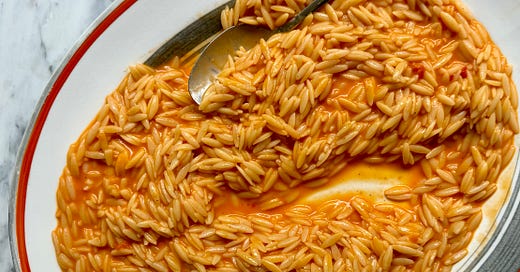I’m not normally a fan of using pasta as a side dish, preferring it to be the focus of a meal.
Or, more accurately, given that in my house pasta is the whole meal at least two times every week, we don’t need it as the supporting act on another day thank you. Penne, spaghetti, fusilli and co as a side doesn’t compute.
… and yet of course there are exceptions to this general rule.
For me, those exceptions are fregola, orzo and, when it’s under a cheesy blanket, elbow macaroni. (Plus fist bumps to couscous and spätzle…).
The fact orzo looks like grains of rice should immediately open your mind to this shape’s utility.
There’s also something particularly enjoyable about its naturally silky nature. If cooked and dressed correctly, the grains roll loosely over and around the tongue, lubricated by stock, purée, oil (or all three), plus the juices of whatever its served alongside … which might well be things like roast chicken, slow-cooked lamb shoulder, poached trout, baked white fish, roast winter squash or griddled halloumi.
Orzo is also a fantastic carrier and spreader of flavour. For things so small and slippery, the grains do a fine job of clinging onto a sauce and depositing it into your mouth.
Not convinced? Does orzo have a bad rep? I think probably yes. Perhaps because when it’s overcooked and dressed unimaginatively, orzo is bland and stodgy. Maybe people also think it’s a bit childish, or student-y? Has it been pigeon-holed through the horrifically named (but actually often excellent) ‘orzotto’ style dishes?
If you’re not a fan, or you’re dubious as to whether it works as a side dish, I hope this week’s recipes go some way to changing your view.
To my mind and palate, orzo represents a really quick to cook and affordable carb: one that can be used as the core side dish for a huge number of different centrepieces; one that can be dressed-up in a wide variety of ways; and one that works in tandem nicely alongside loads of different vegetables and sauces (especially brocolli, chard, spinach, cavolo nero, peas, mangetout, sugar snaps, asparagus, courgettes, green beans and broad beans).
What lies beneath?
Lots! Including these three sides, which I hope take your fancy:
Wild mushroom and sage orzo — the slightly brothy and very savoury one.
Red pepper, fish stock and saffron orzo — the one to go with pretty much anything that swims in the sea or crawls over the seabed.
Cacio e pepe (ish) orzo — the one that goes with lots of things, not least any kind of chicken, multiple different roast vegetables, plus rich, beefy braises and stews.
Also below are other general tips for cooking and embellishing orzo so that it works as a side.
And outside of this post, you could flick to page 282 in my book On The Side for ‘chicken stock orzo’ and page 44 for purple sprouting with orzo, ricotta and a few other bits. Or click into the glossy orzo partner of this spatchcocked chicken — think smoked pancetta, tenderstem broccoli (broccolini), plus a dollop of that tarragon yoghurt dressing over the top. Lush.
Enjoy! And see you again next week, Ed.
On The Side recipes are for paid subscribers.
If you’re tempted by this week’s sides, last week’s coconut granola and vanilla and honey baked plums, or indeed any of the recipes and posts from the ever-growing Archive, then now is the time to upgrade your subscription.
As from next Tuesday (1st October), costs rise a little: to £5.50 a month / £49 a year.
If you subscribe before then, you’ll only ever pay the current price (£5 a month / £45 a year).
NB: if you’re already a paid subscriber, nothing changes — THANK YOU for supporting this publication.
General thoughts on using orzo as a side dish
It’s just pasta, right? So you know how to cook it: i.e. dropped into already boiling, generously salted water … until it’s done.
A few additional pointers:





